Hydrogeological situation on 1 March 2024
In February 2024, there were different trends in reactive aquifers. Recharging continued in the inertial aquifers but slowed down in several areas.
The state of the aquifers is very satisfactory over a large part of France, due to abundant rainfall at the beginning of the recharge period. It is less satisfactory, with low to very low levels, in the inertial aquifers in the Sundgau and the Saône corridor and in the Languedoc aquifers, from the south of the Massif Central to the coastline, and in the Roussillon aquifers.
Over the winter and until vegetation starts growing again, the trends and the changing states of aquifers will depend mainly on rainfall. The surplus recharge means that satisfactory levels can be expected for much of the country at the end of winter. However, if there is insufficient rainfall in March and April, the state of the reactive aquifers could rapidly deteriorate, and that of the inertial aquifers could also worsen, but at a slower rate. The state of the aquifers in the south-east of France needs to be closely monitored, since they remain particularly vulnerable due to severe low-water periods over recent years and the lack of any significant recharge episodes.
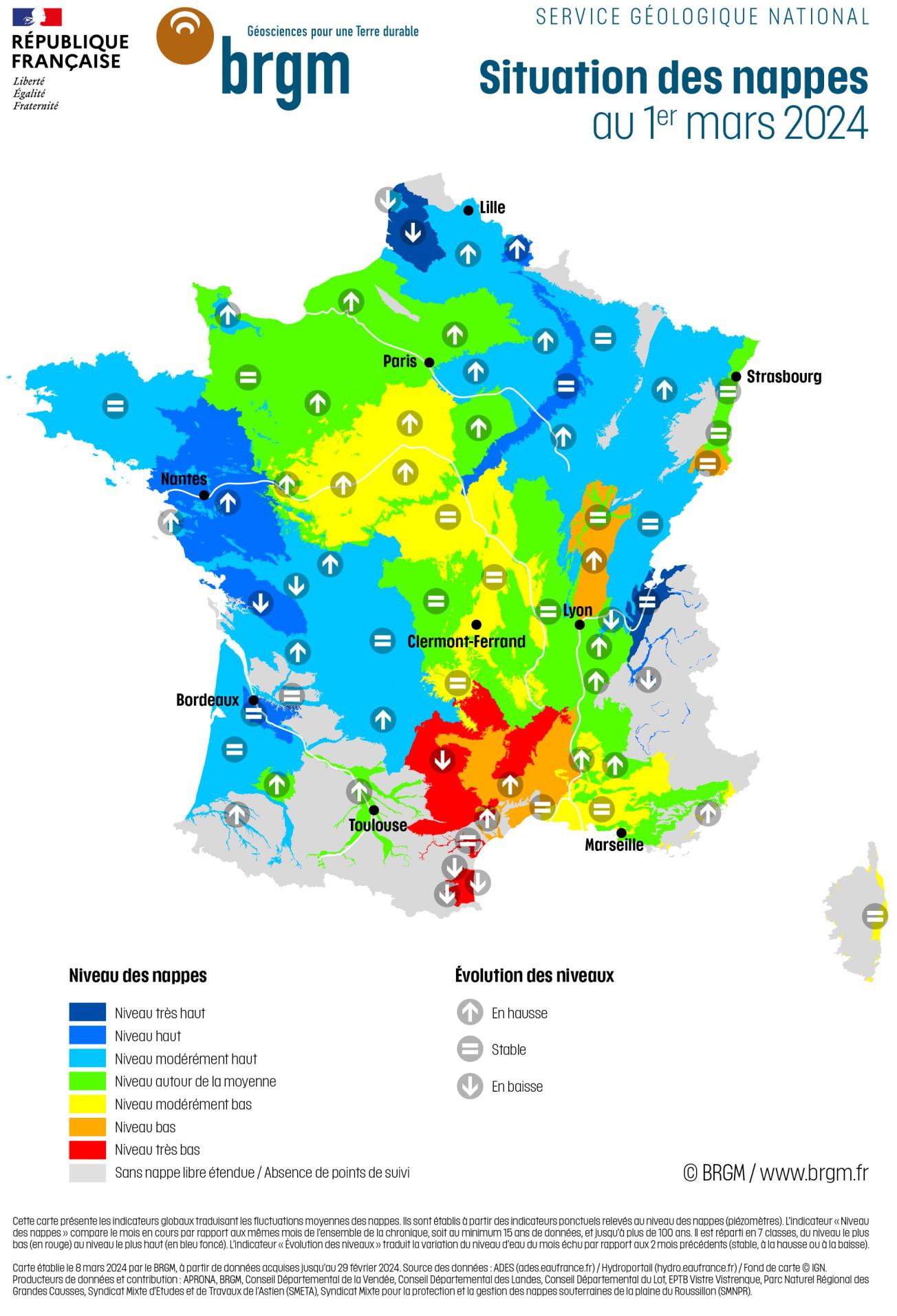
Map of aquifer levels in mainland France on 1 March 2024.
© BRGM
Groundwater trends
In 2023, the depletion period continued late in the year, due to insufficient rainfall and the fact that the vegetation remained active at the beginning of autumn due to the warm temperatures. The recharge began at the end of October and remained extremely active in November and December. In January, it slowed across much of the country. Only the aquifers around the Mediterranean had a weak recharge.
In February 2024, recharging of the water tables continued, but remained slow in many aquifers. Higher levels were recorded at 57% of the observation points (as opposed to 51% in January).
The reactive aquifers in the northern two-thirds and south-west show differing trends. From Alsace to the northern Alps and in the Massif Central, levels have stabilised due to low rainfall. But stable or falling levels are not always correlated with below-normal rainfall. Indeed, with a relatively dry January, February rains probably had difficulty infiltrating deep through the relatively dry soil.
In the inertial aquifers in the Paris Basin, the Sundgau and the Rhône-Saône corridor, the levels have risen. Due to the inertia of these aquifers, it takes several weeks for rainfall to infiltrate through the unsaturated zone. The increase in levels recorded in February were therefore due to the effective rainfall that had infiltrated into the ground over the last few months. However, the intensity of the recharge is slowing in some areas that received little rainfall in January and February, particularly in the Rhône-Saône corridor.
Lastly, in the south-south-east and Corsica, trends are heterogeneous because they depend on cumulative rainfall and soil humidity. Levels are generally slightly up or stable. They continue to fall in the aquifers of the Roussillon plain and the Corbières massif, with rainfall remaining less than normal.
Comparison between 1 March 2023 and 1 March 2024
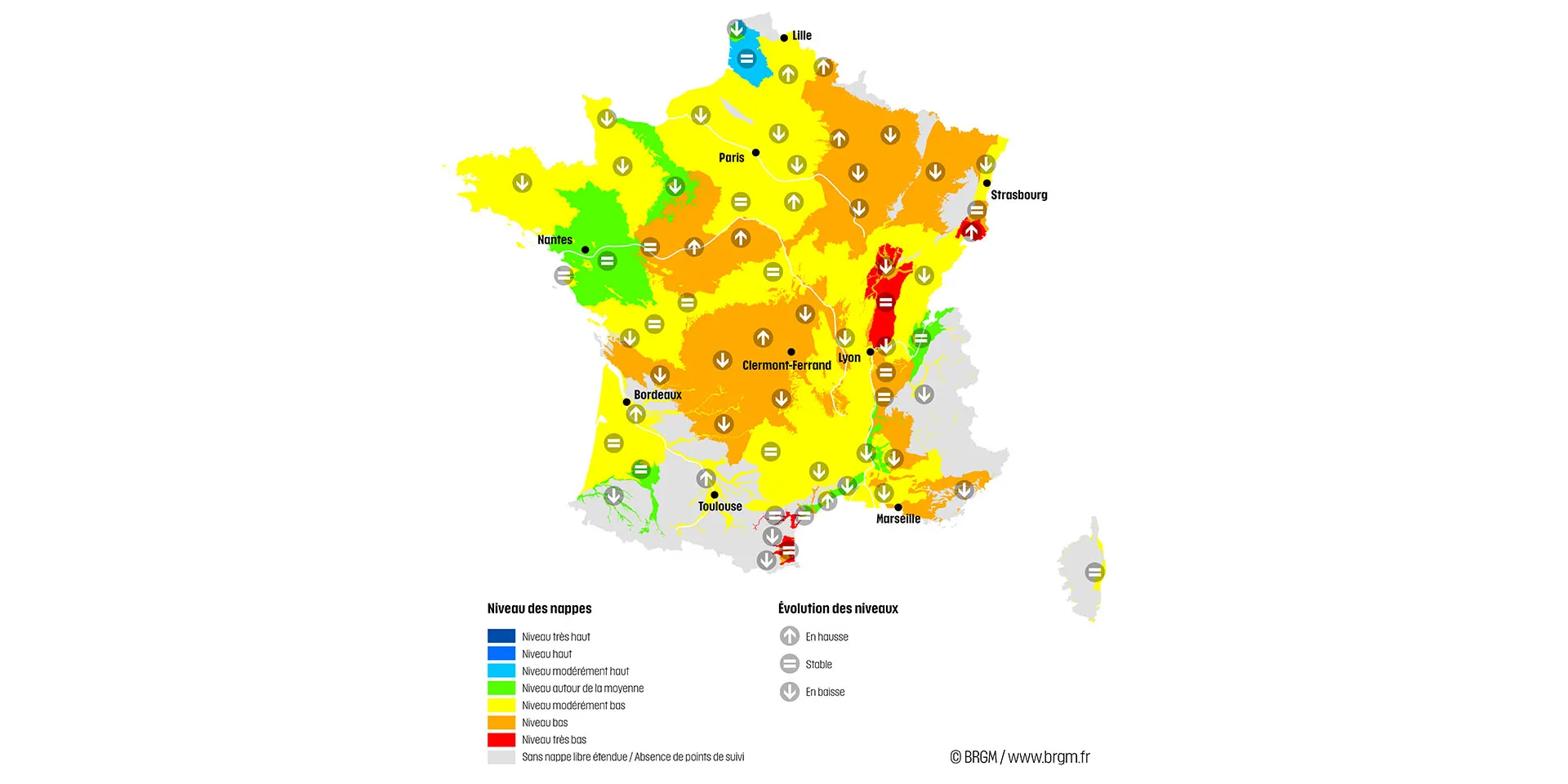
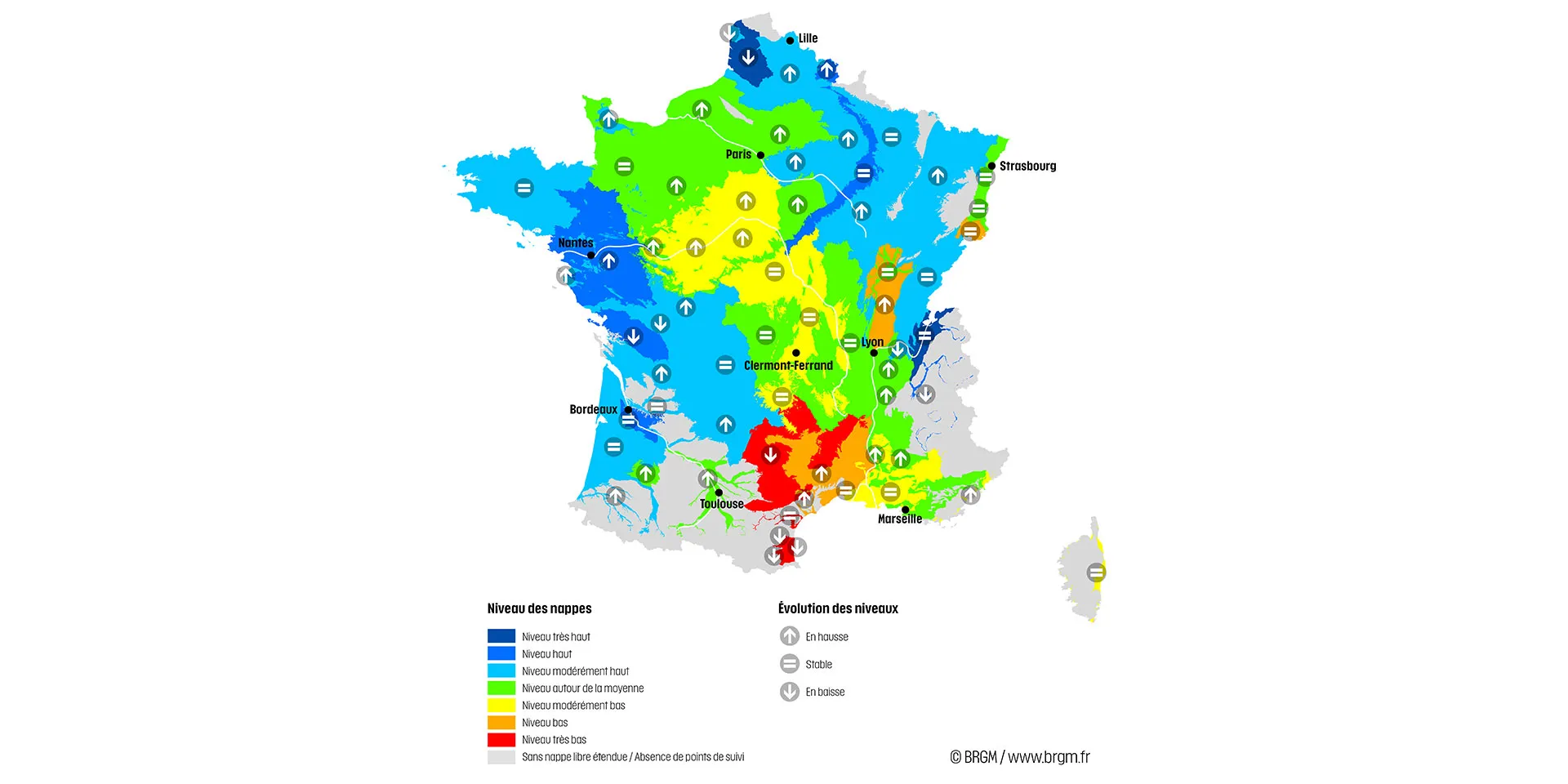
Map of France showing the state of the aquifers on 1 March 2023 (left) and 1 March 2024 (right).
© BRGM
The groundwater situation
The groundwater situation during the low-water period in 2023 was unsatisfactory, with aquifer levels being generally below monthly averages. The significant recharge that occurred between the end of October and December had a marked effect on the aquifers. The overall situation then improved considerably, particularly in the reactive aquifers in the northern two-thirds and south-west of France. In January, the situation deteriorated, with levels starting to fall again, but remained satisfactory.
In February, the situation was stable compared with the previous month. The state of the aquifers was, on the whole, satisfactory: the levels recorded at 36% of the observation points were below monthly norms, 18% were comparable with monthly norms and 46% were above average (compared, respectively, with 39%, 15% and 46% in January). The situation was more positive than that observed last year, in February 2023, when 80% of the levels recorded were below monthly averages. Only the Languedoc and Roussillon aquifers had levels that were lower than in February 2023.
The state of the aquifers in February 2024 remained heterogeneous. The levels are satisfactory, from moderately high to very high, in the south-west, from Brittany to the west of the Massif Central and the Pyrénées-Atlantiques, and in the north-east, from the Artois region to the Alpine valleys. The levels are moderately low or comparable with monthly averages over the central area of the country stretching from Normandy to Corsica. Finally, the levels are less satisfactory, from low to very low in southern Alsace, the Saône corridor, the southern Massif Central, Languedoc and Roussillon. The reasons for these different situations are essentially linked to the intensity of the 2023-2024 recharge period and to how quickly the different aquifers respond to rainfall.
In the reactive aquifers in the northern two-thirds and south-west of France, the rainfall that had been filtering into through the ground from mid-October to December helped to improve the situation. In February, compared with January, the situation remained stable or deteriorated slightly, mainly in areas with insufficient rainfall. They remain satisfactory on the whole, with moderately high to high levels, and even very high levels in the mixed chalk aquifer on the Artois-Picardie coast. The aquifers in the central and northern parts of the Massif Central had an insufficient recharge, with their levels ranging from close to average to moderately low. The aquifers in the Alsace plain suffered from a lack of rainfall in February and their levels dropped to near normal levels.
As for inertial aquifers, their state continues to improve very slowly. The levels are moderately high to moderately low in the Paris Basin, with less favourable situations in the western central area. The levels of the inertial aquifers in the Sundgau (southern Alsace) and the Saône corridor are low and the aquifers in the Rhône corridor are comparable to normal, but this varies locally. For example, the levels at observation points for aquifers in the fluvio-glacial corridors east of Lyon are moderately low, while those in the north of Isère are moderately high. Finally, very high levels have been recorded in the Artois coastal chalk aquifers and in the Savoyard foothills aquifer, following a moderately low water level in 2023 and several significant recharge episodes since mid-October 2023. It should be noted that these high levels could contribute to flooding events.
In the south-east (south of the Massif Central, in the Cévennes region, along the Mediterranean coastline and in Corsica), current levels are the result of below-normal levels during the 2023 low-water period and a recharge deficit during the autumn and early winter. In February, the situation improved for aquifers in Provence, the Côte d'Azur and Corsica. Recharging is gradually making up the deficits, but some areas are still showing less favourable levels (Bouches-du-Rhône and Var). In the Languedoc region, the rainfall recorded in February was still insufficient to generate a recharge, and the situation is of some concern with levels being low to very low. Finally, with scant rainfall for more than a year, levels are still a cause for concern in the limestone aquifers of the Corbières massif and the Roussillon plain.
Aquifers that are in a very good state
Several aquifers are in a very good state, with levels ranging from high to very high, in relation to the levels recorded for February in previous years:
- Levels of the carboniferous limestone aquifers in the Avesnois area and the Cenomanian marly chalk aquifers of the Artois-Picardie coast are the result of a high surplus recharge in 2022-2023 and exceptional rainfall since the end of October 2023;
- The fluvial and fluvioglacial alluvial aquifers of the Savoyard foothills and the Alpine valleys benefited from a much higher recharge surplus in 2023-2024;
- The levels of the reactive aquifers of the Vilaine basin basement in the Vendée bocage area and the Jurassic limestone formations of the Charentes region are very high, due to abundant rainfall between mid-October and December 2023 and recharge from rainfall in February.
Aquifers in a poor state
Several aquifers are in a poor state, with low to very low levels compared to those recorded in February of previous years, due to an extreme lack of rainfall over the last few months or years:
- The situation is improving very slowly in the Plio-Quaternary gravel inertial aquifers in the Sundgau area and the Dijonnais, Bresse and Dombes regions, but levels remain low due to poor recharges over several successive winters and the high degree of inertia of the aquifers which receive this infiltrated rainfall.
- Aquifer levels in the basement of the southern Massif Central, in the limestone formations of the Grands Causses and the Cévennes region, and in the Tertiary and alluvial formations along the Languedoc coast are low to very low, with insufficient rainfall in February to recharge the aquifers after several months of deficits.
- The states of the multi-layer aquifer in Roussillon and the karst limestone aquifer in the Corbières massif remain extremely poor, with very low levels, due to chronic low rainfall for more than a year. Certain observation points have recorded steadily-falling levels since May 2022, and have even reached historic lows.
How do aquifers fill up and how do they empty?
Groundwater levels vary throughout the year, from high levels in winter (when vegetation does not absorb rainwater) to low levels in summer (the traditional depletion period).
The fate of rainfall varies greatly depending on the time of year and the condition of the ground surface on which it falls. Usually, the groundwater-recharge period takes place from early autumn (September-October) to early spring (March-April), a six-month period during which vegetation is dormant (with low evapotranspiration) and rainfall is generally more abundant. If the winter is dry, groundwater recharge is very low.
From spring through summer, rising temperatures coupled with the regrowth of vegetation and thus increased evapotranspiration, limit the infiltration of rainfall into aquifers. Between May and October, unless there are exceptional rainfall episodes, aquifer depletion usually continues and levels will keep decreasing until the autumn.
Why do some aquifers recharge faster than others?
Groundwater flows at different rates depending on the porosity (percentage of gaps/cracks in the rock) and permeability (capacity to allow water to circulate, i.e. interconnectivity between these gaps/cracks) of the aquifers. The larger the gaps and the more interconnected they are, the faster the water will flow, for both refilling and depletion.
It takes a given volume of water different periods of time to travel the same distance, depending on the kind of rock formation:
- a few years in a porous formation,
- a few months in a cracked formation,
- and a few days, or even a few hours, in a karst formation.
Inertial and reactive aquifers: what are they?
The impact of the winter recharge varies according to the cyclic nature of the aquifer, i.e., its reactivity to rainfall infiltration.
We refer to aquifers that are:
- reactive (when they are composed of sand, gravel, karst limestone or weathered granite formations). These aquifers are characterised by their rapid reaction times: they can recharge during heavy summer rainfall, but are also highly sensitive to drought. Their levels can therefore vary very quickly over the course of the same season.
- inertial (when composed of chalk, non-karst limestone, sandstone formations). Their reaction times are slow. They can have multi-annual cycles, meaning that they require a long period to recharge or empty.

Cyclicity of aquifers in mainland France.
© BRGM
Forecasts
The Météo-France seasonal forecasts for March, April and May 2024 predict higher temperatures across the whole of France. No clear scenario has emerged concerning rainfall.
Several low-pressure systems have been observed or are forecast for March 2024 over the whole country. Recharging may therefore continue. The groundwater situation should improve rapidly in areas with reactive aquifers that benefit from sustained recharge periods, whereas the improvement will be slower in areas with inertial aquifers or which receive less rainfall. In the event of significant accumulated rainfall, the most reactive aquifers (basement, karst limestone, alluvial) could experience sharp rises in water levels. However, in the event of insufficient rainfall, the recharging should pause and the situation could deteriorate more or less rapidly.
In the longer term, the trends and changes in the state of the aquifers, with the resumption of vegetation growth in the spring, will depend entirely on the total accumulated rainfall. If there is insufficient precipitation, infiltrated rainfall will not compensate for the output volumes (through natural outlets and due to abstractions). On the contrary, sufficient rainfall will help maintain active recharging and maintain or even improve the state of aquifers.
For the inertial aquifers (in the Paris Basin, southern Alsace and the Rhône-Saône corridor), the situation should continue to evolve slowly. If there is a normal or surplus amount of rainfall between now and spring, many of the inertial aquifers should reach close-to-average levels. However, the Plio-Quaternary aquifers in the Sundgau and the Saône corridor (Dijonnais, Bresse and Dombes) are likely to remain below monthly averages. It is unlikely that the volumes of water infiltrated at the end of the 2023-2024 recharge period will be able to compensate for the deficits accumulated in recent years. If there is insufficient rainfall in March over the inertial aquifers, the recharge should continue to slow or even cease. If the deficits continue into early spring, the depletion period could resume and last until the autumn.
As regards the reactive aquifers in the northern and south-western parts of the country, levels should remain satisfactory in March, unless there are significant rainfall deficits. The above-normal levels observed two-thirds of the way through the recharge period indicate that there may be satisfactory levels at the end of the winter. However, the situation can deteriorate rapidly if there is insufficient rainfall at the end of winter. Finally, rainfall in early spring is important for maintaining high levels and delaying the start of the depletion period.
As far as the Languedoc and Roussillon aquifers are concerned, the impact of the rainfall at the end of February will probably be limited. Any rain that falls after a long dry spell will initially serve to moisten the soil, before infiltrating deeper into the ground. In the event of heavy, well-distributed rainfall in March, rain could infiltrate deep into the ground and recharge the water table. Rain should be able to infiltrate more easily into the aquifers in Provence, the Côte d'Azur and Corsica after the first rainy spells in February. In the longer term, the aquifers along the Mediterranean coastline could reach satisfactory levels by the end of winter if the rains continue. However, it is difficult to imagine the aquifer reserves in the Roussillon region reaching above average levels by spring 2024 or being fully refilled on a long-term basis.
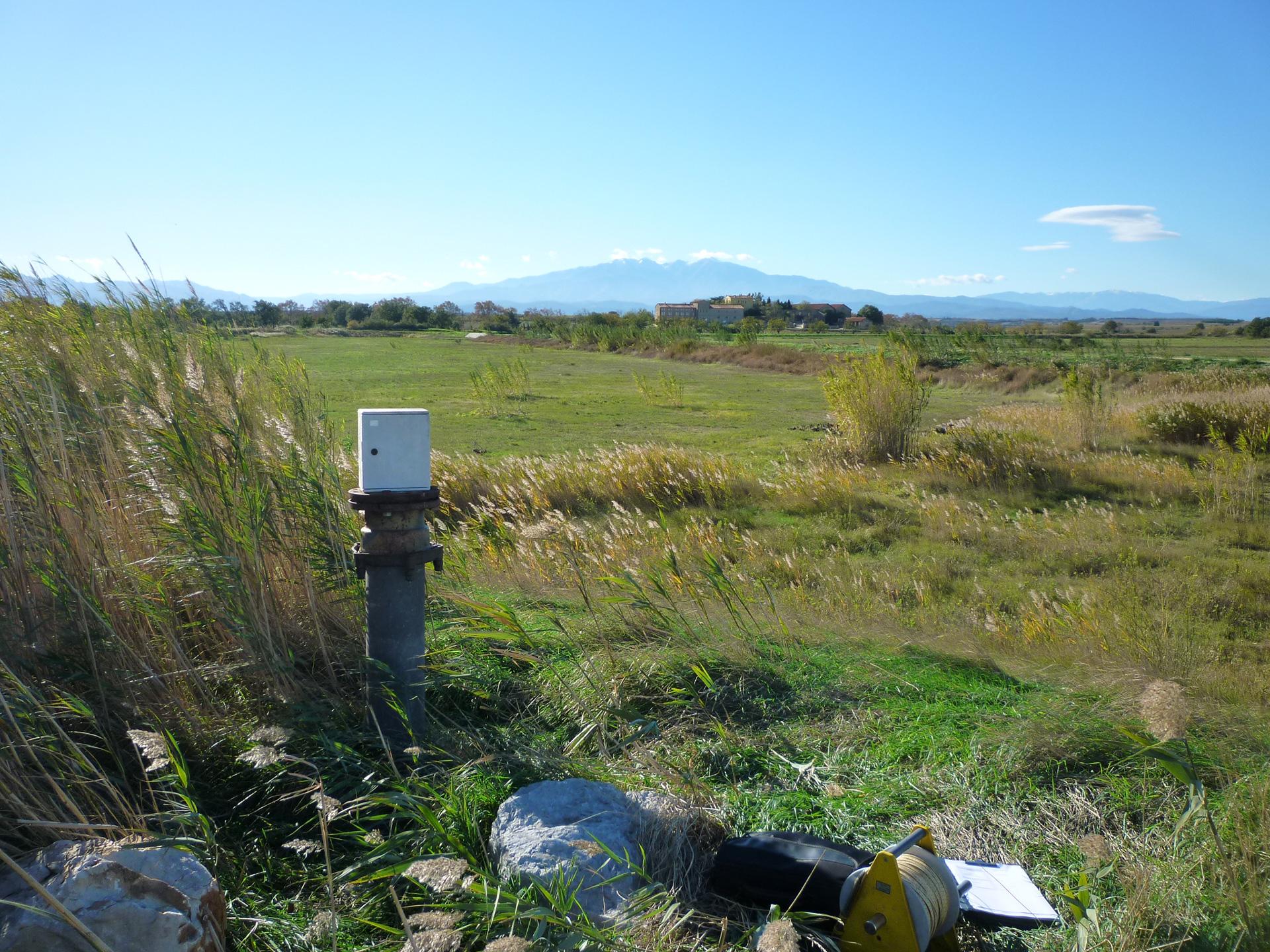
State of groundwater: monitoring by BRGM
Groundwater is a widely used resource: in metropolitan France, it accounts for nearly two-thirds of drinking water consumption and more than one-third of agricultural water consumption. It is also widely used in the industrial sector. Groundwater tables depend on cyclical recharges.
BRGM monitors groundwater levels and quality in mainland France. Discover the actions carried out by the French geological survey and the resources and databases available on groundwater in France.
Press contact


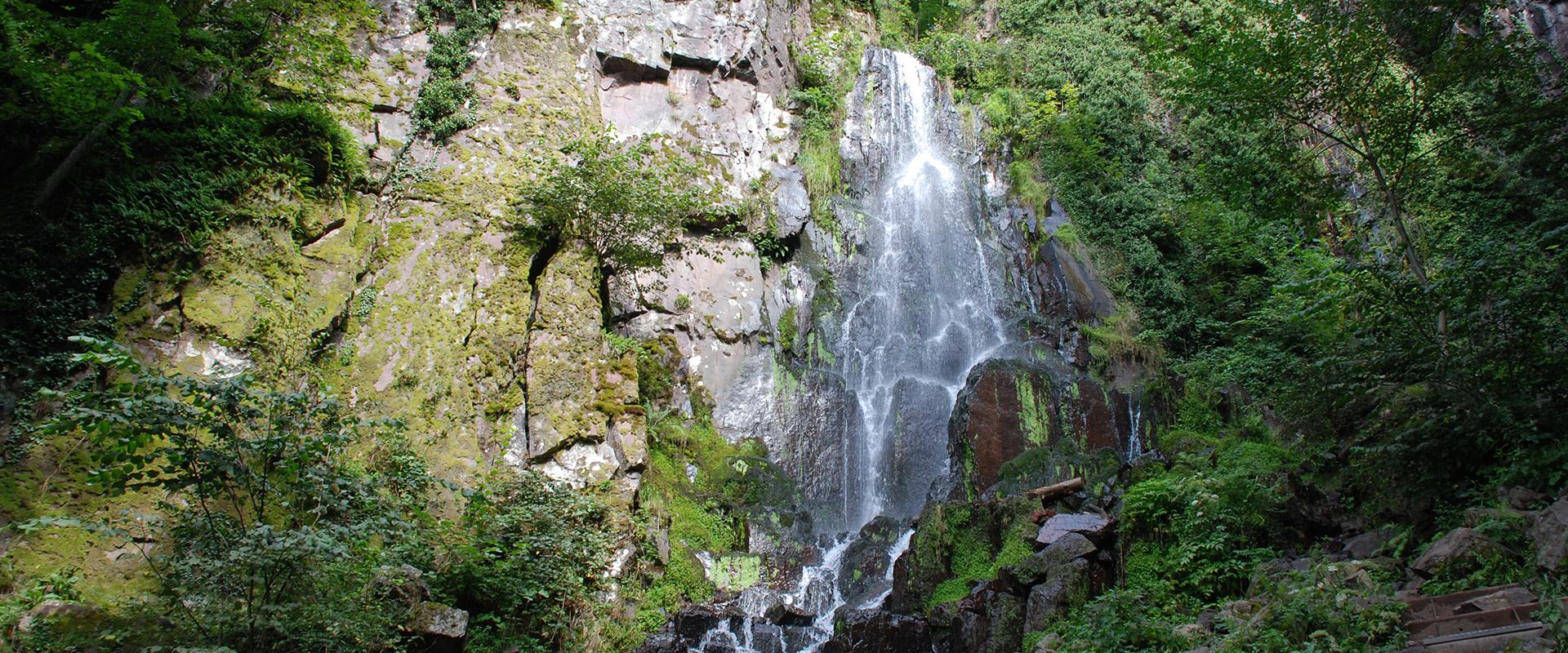
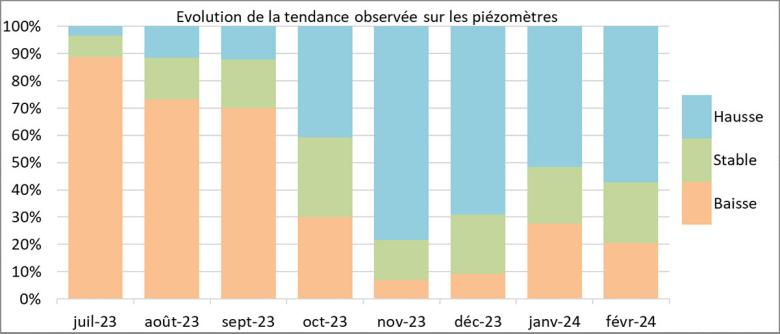
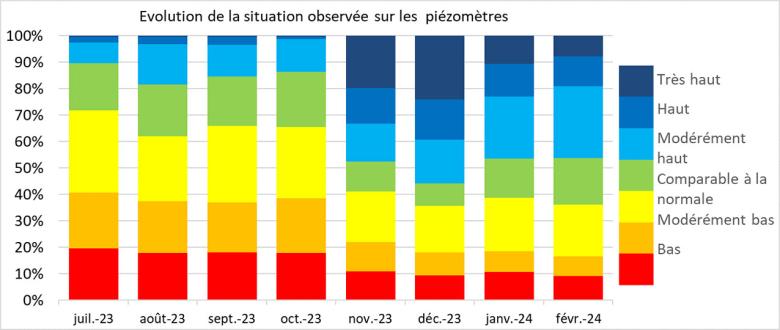




Map drawn up by BRGM on 8 March 2024, based on data from the ADES database, acquired up to 29 February 2024. Data source: ADES database (ades.eaufrance.fr) / Hydroportail (hydro.eaufrance.fr) / Background map © IGN. Data producers and contributors: APRONA, BRGM, Conseil Départemental de la Vendée, Conseil Départemental des Landes, Conseil Départemental du Lot, EPTB Vistre Vistrenque, Parc Naturel Régional des Grandes Causses, Syndicat Mixte d'Etudes et de Travaux de l'Astien (SMETA), Syndicat Mixte pour la protection et la gestion des nappes souterraines de la plaine du Roussillon (SMNPR).
This map shows the global indicators reflecting the average fluctuations of the aquifers. They are based on point indicators collected at groundwater monitoring points (by means of piezometers).
The "Aquifer levels" indicator compares the current month’s figures with those of the same months in the entire record, i.e. at least 15 years of data and sometimes up to as much as 100 years of data. It is divided into 7 classes, from the lowest level (in red) to the highest (in dark blue).
The grey areas correspond to areas without unconfined aquifers, i.e. with an impermeable or semi-permeable layer above the aquifer, and/or sectors with a very low density of measuring points. This last case primarily concerns mountainous areas with small, heterogeneous aquifers.
The "Evolution of levels" indicator reflects the variation of the water level of the past month compared to the two previous months (stable, increasing or decreasing).
These global indicators reflect general situations and trends and do not take into account possible local disparities.